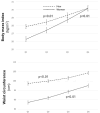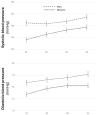Urate Levels as a Predictor of the Prevalence and Level of Cardiovascular Risk Factors: An Identificación de La PoBlación Española de Riesgo Cardiovascular y Renal Study
- PMID: 39766237
- PMCID: PMC11673880
- DOI: 10.3390/biom14121530
Urate Levels as a Predictor of the Prevalence and Level of Cardiovascular Risk Factors: An Identificación de La PoBlación Española de Riesgo Cardiovascular y Renal Study
Abstract
(1) Background: Urate levels lower than the classical cut-off point for defining hyperuricemia can increase cardiovascular risks. The aim of this study is to determine if there is a relationship between different urate levels and classic cardiovascular risk factors (CVRFs). (2) Methods: A cross-sectional study of the inclusion visits of the patients recruited to the IBERICAN study was conducted. The patients were classified into quartiles according to their distribution of urate levels and separated by sex; the three lower points corresponded to normal levels of urate, and the highest quartile was determined according to the classical definition of HU. Multivariate analysis models, adjusted for epidemiological variables, were used to analyze the association of urate levels with CVRFs. (3) Results: The presence of CVRFs was higher across the quartiles of urate, with a continuous increase along the quartiles in both sexes in accordance with body mass index (p < 0.01), waist circumference (p < 0.01), blood pressure (p < 0.01), and LDL cholesterol (p < 0.01). The CV risk estimated by SCORE was associated with an increase along the quartiles in women (p = 0.02). (4) Conclusions: A progressive increase in the frequency of CVRFs, as well as in their levels, was observed across the quartiles of uricemia, which reflects an increase in the CVRs associated with uricemia.
Keywords: cardiovascular risk; hyperuricemia; primary care.
Conflict of interest statement
The authors declare no conflicts of interest.
Figures






Similar articles
-
Hyperuricemia, low urine urate excretion and target organ damage in arterial hypertension.Blood Press. 2003;12(5-6):277-83. doi: 10.1080/08037050310019418. Blood Press. 2003. PMID: 14763658
-
Serum uric acid and its relationship with metabolic syndrome and cardiovascular risk profile in patients with hypertension: insights from the I-DEMAND study.Nutr Metab Cardiovasc Dis. 2014 Aug;24(8):921-7. doi: 10.1016/j.numecd.2014.01.018. Epub 2014 Feb 8. Nutr Metab Cardiovasc Dis. 2014. PMID: 24675005
-
Prevalence of hyperuricemia and relation of serum uric acid with cardiovascular risk factors in a developing country.BMC Public Health. 2004 Mar 25;4:9. doi: 10.1186/1471-2458-4-9. BMC Public Health. 2004. PMID: 15043756 Free PMC article.
-
Hyperuricemia and Risk of Cardiovascular Outcomes: The Experience of the URRAH (Uric Acid Right for Heart Health) Project.High Blood Press Cardiovasc Prev. 2020 Apr;27(2):121-128. doi: 10.1007/s40292-020-00368-z. Epub 2020 Mar 10. High Blood Press Cardiovasc Prev. 2020. PMID: 32157643 Review.
-
[Is hyperuricemia a cardiovascular risk factor?].Wiad Lek. 2006;59(5-6):364-7. Wiad Lek. 2006. PMID: 17017483 Review. Polish.
Cited by
-
Evaluating an Early Risk Model for Uncomplicated Hypertension in Pregnancy Based on Nighttime Blood Pressure, Uric Acid, and Angiogenesis-Related Factors.Int J Mol Sci. 2025 Jun 25;26(13):6115. doi: 10.3390/ijms26136115. Int J Mol Sci. 2025. PMID: 40649890 Free PMC article.
References
MeSH terms
Substances
LinkOut - more resources
Full Text Sources

